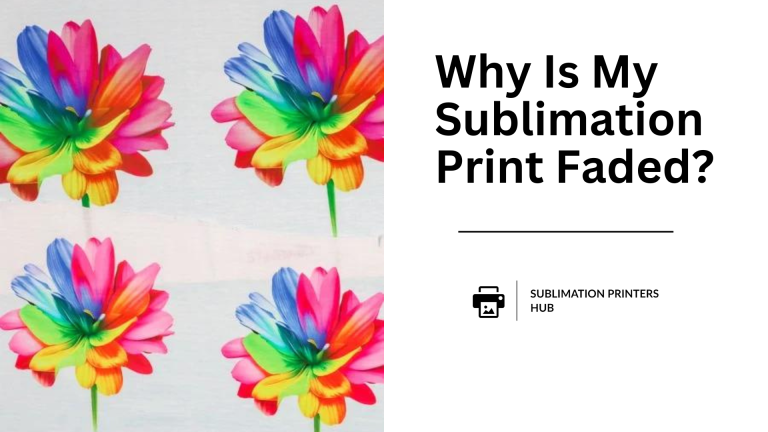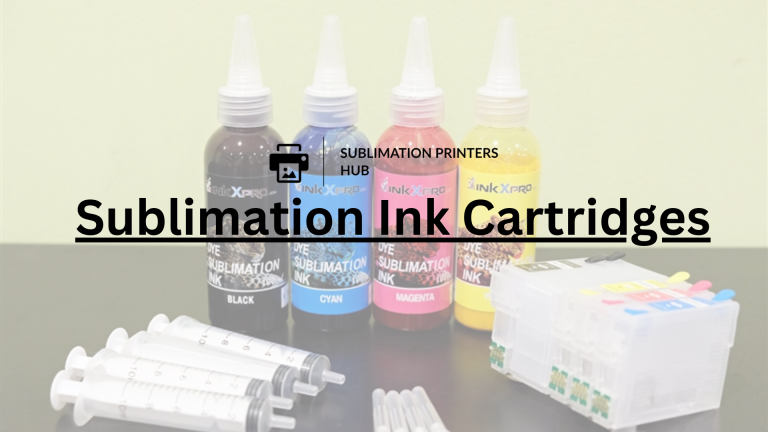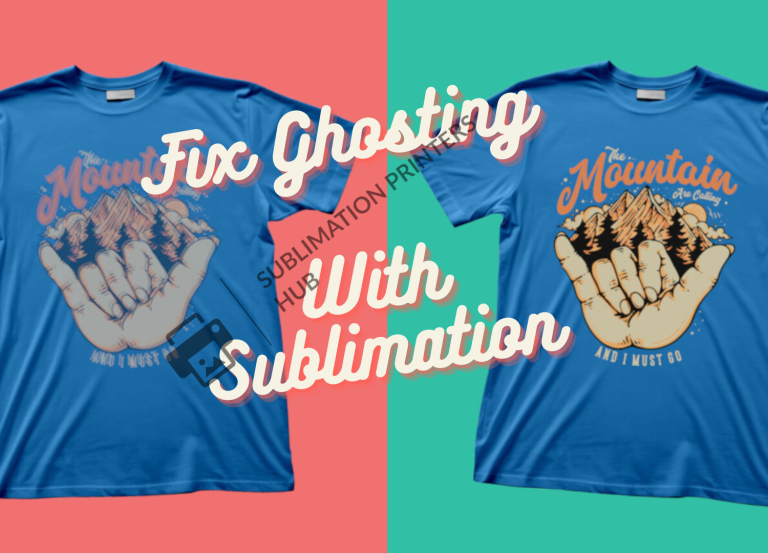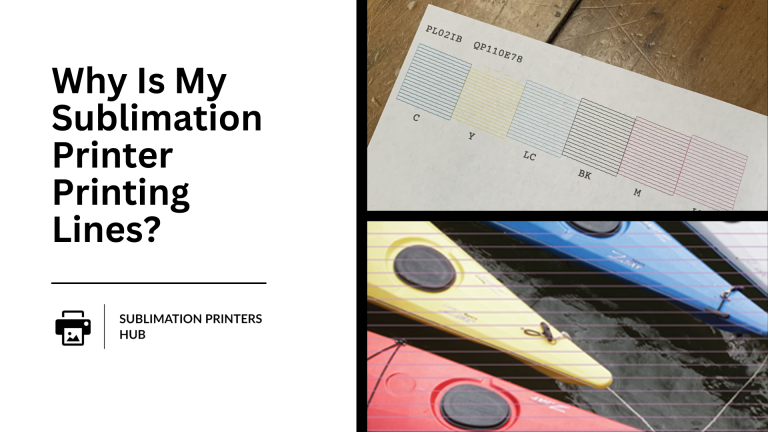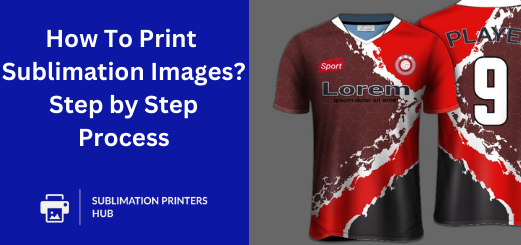Hey there, fellow printing fans! This is a full guide to DTF printing from a printing expert, Michel. When I first heard about DTF printing (Direct-to-Film), I wasn’t sure it would work. I had used sublimation printing for years and wondered if this new tech could deliver. But after a lot of testing, experimenting, and even some disappointing failures, I can state with confidence that DTF printing has changed the way we produce custom clothes.
What Is DTF Printing?
Let me break it down for you in a way that I wish someone had done for me when I was first starting out. DTF stands for “Direct-to-Film printing.” This is a new way of printing that uses water-based pigment inks to print images directly onto a specific PET film. Then, using heat and pressure, the designs are transferred to different fabrics.
DTF printing doesn’t need the substrate to have polyester in it, unlike sublimation printing, which I’ve written a lot about on my site. This was the thing that really got my attention. DTF printing works on cotton, polyester, mixes, silk, and even synthetic materials. At first, I found it hard to believe that sublimation could work on certain types of fabric.
How DTF Printing Works: Step-by-Step Process
After I set up my first DTF printer (which was quite an experience!), I found that there are a few important processes involved in the DTF printing process. Here’s what I’ve learned after trying a lot of things:
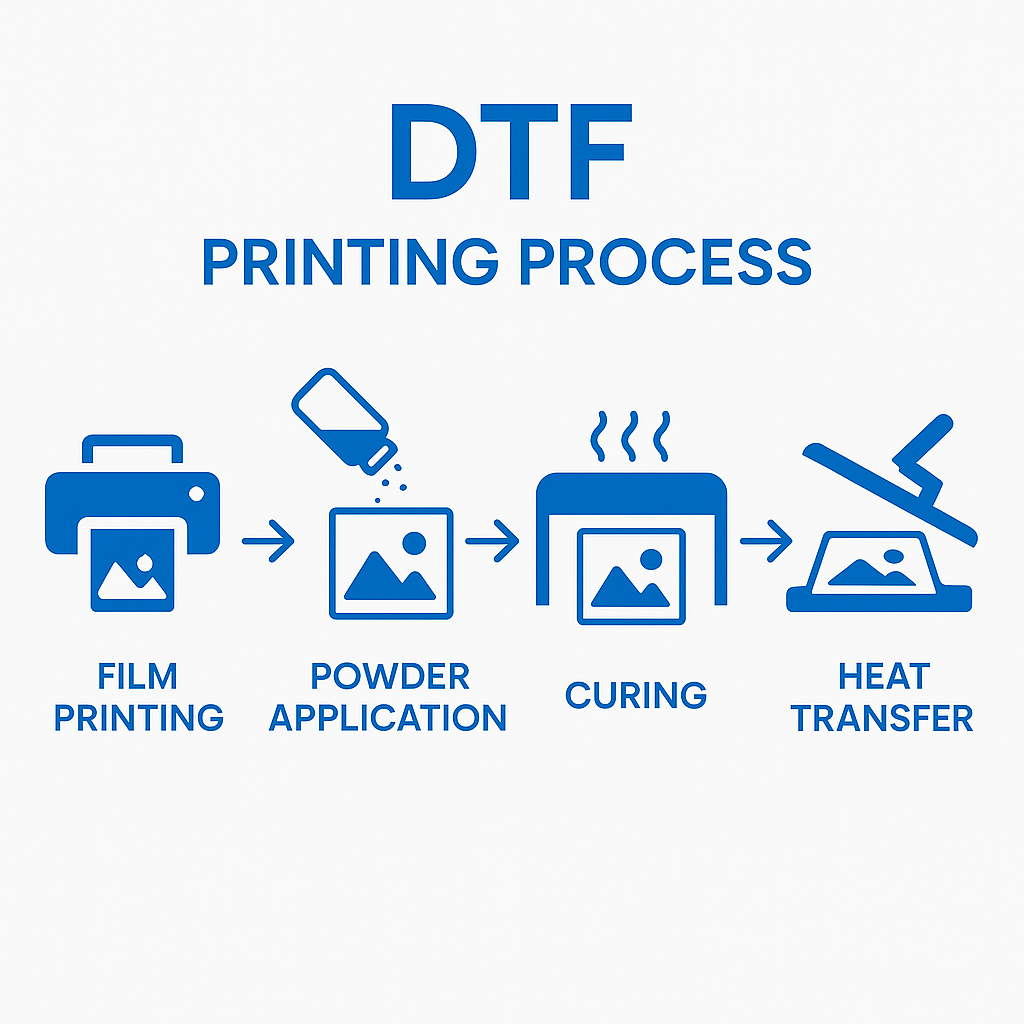
1) Make the design and get it ready
The first step in the process is to use RIP software to make your design. For the best results, I use tools like Flexiprint and Maintop. The design has to be “mirror-reversed” because it will be flipped during transfer. I learned this the hard way after damaging a few early prints.
2) Printing on DTF Film
Using special DTF inks, the pattern is printed onto PET film. The white ink layer, which is printed first as a basis and then the colored design, was the most interesting part to me. This white underbase is what makes DTF work on dark textiles, which sublimation can’t achieve.
3) Apply the powder
This is where the magic happens. When the ink is still wet, adhesive powder is spread uniformly over the design that has been produced. At first, I had trouble with this stage. Too much powder makes it feel thick and uncomfortable, and too little makes it not stick well.
4) Curing the Powder
The film goes into a curing oven at 160–170°C for 2–5 minutes. This process melts the powder, creating a glue layer that will adhere to the fabric. When I started, I utilized a heat press in “hover mode.” It worked, but using a real curing oven made a huge difference.
5) Press the Fabric Before
Before transferring, the cloth needs to be pre-pressed for 2–5 seconds to get rid of moisture and smooth out the surface. This step prevents transfer failures, a realization I came to after experiencing several poor results.
6) Transfer of Heat
The film is put on the pre-pressed cloth and heated at 160–170°C for 15–20 seconds. The heat and pressure make the glue work, permanently sticking the design to the fabric.
7) Peeling and finishing
The film is taken off once it has cooled down (for cold-peel films) or right away (for hot-peel films). A last “post-press for 10–15 seconds” makes sure that the item will last as long as possible and won’t fade when washed.
Comparison: DTF vs. Sublimation Printing
I get asked a lot about the differences between the two because I’ve used both a lot.
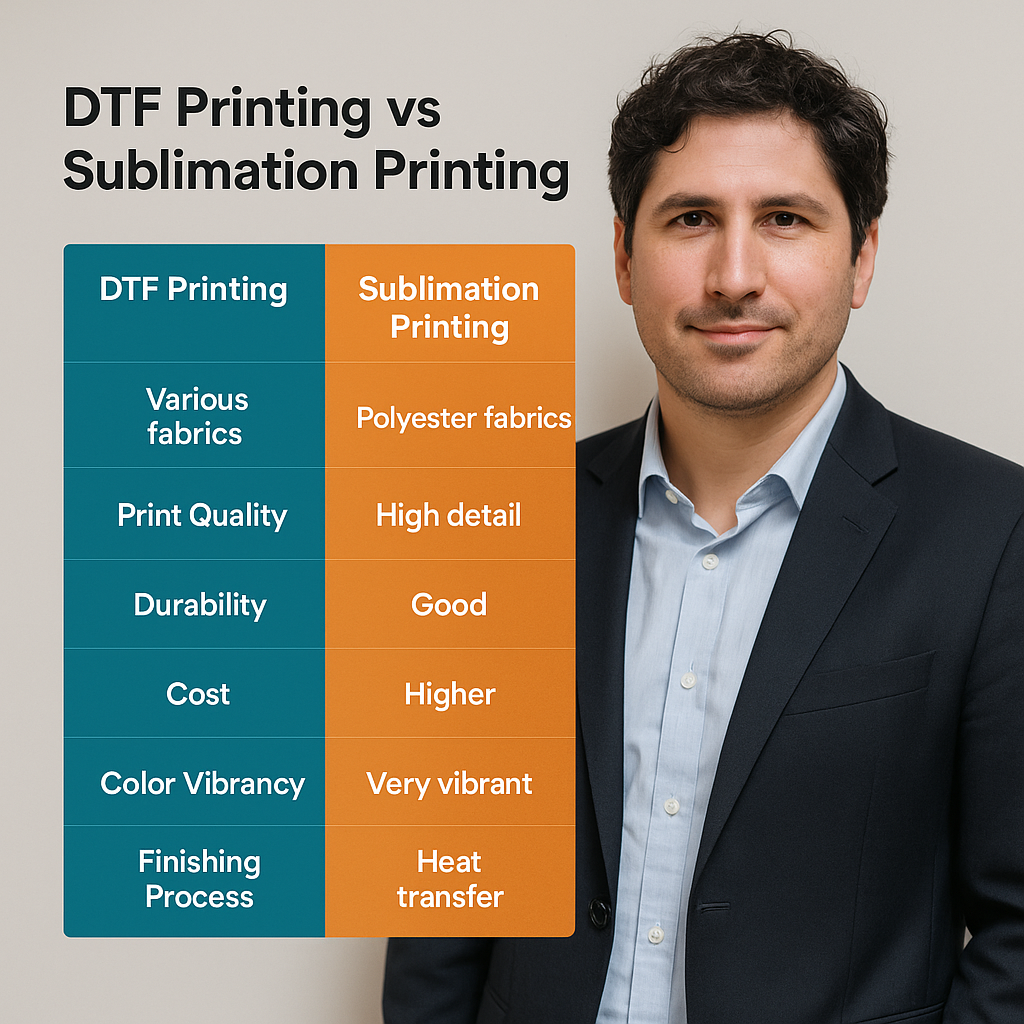
My honest opinion is this:
Benefits of DTF Printing:
- Works on any type and color of fabric
- Makes colors that are bright and have a lot of detail
- No need to treat the fabric first
- Costs of setting up are lower than some other options
DTF Restrictions:
- Slight tactile feel on the fabric surface
- A more complicated technique than sublimation
- Costs for consumables that keep coming can pile up
Benefits of Sublimation:
- No hand-feel—the prints become part of the fabric
- Very strong and resistant to fading
- Easier to do once you know how
Sublimation Problems:
- Only works with polyester and light-colored fabrics
- Can’t print real white colors
Equipment and Investment: What You Really Need
Let me be clear about the costs. This is information I wish I had known before I started my DTF journey.
Necessary Tools for DTF Printing:
1) DTF Printer: $1,500 to $20,000 or more, depending on size and features
2) Heat Press: $200 to $9,000, depending on the size and quality
3) Curing Oven: $500 to $9,000
4) Powder Shaker: This is often part of commercial setups
Costs that keep coming up:
1) DTF Film: $1 to $3 per sheet
2) DTF Inks: $100 to $200 per liter
3) Powder for Adhesives: $20 to $50 per kilogram
4) Maintenance: $50 to $200 a month
What I would do is see how things go and start with a basic configuration that costs between $5,000 and $7,000. You can constantly get better as your business expands.
Common DTF Printing Problems and Solutions
I have seen almost every DTF printing difficulty you can think of in my years of expertise. Here are the most common problems and how I fixed them:
Problem 1) Ink Smudging
Cause: Not enough time for the ink to dry or too much ink being used
Solution: Change the curing settings and make sure the powder dries completely before applying it.
Problem 2) Bad Adhesion
Cause: Using the wrong temperature, pressure, or powder
Solution: Check that the heat press settings match the film specifications and make sure the powder is spread evenly.
Problem 3) Problems with White Ink
Cause: Clogged nozzles or white ink settling
Solution: Regular ink circulation and printhead maintenance.
Problem 4) Colors that don’t match
Cause: Nozzles that are clogged or color profiles that are wrong
Solution: Clean the nozzles and calibrate the printer on a regular basis
Business Applications and Opportunities
DTF printing has brought up amazing business prospects that I never had with sublimation alone:
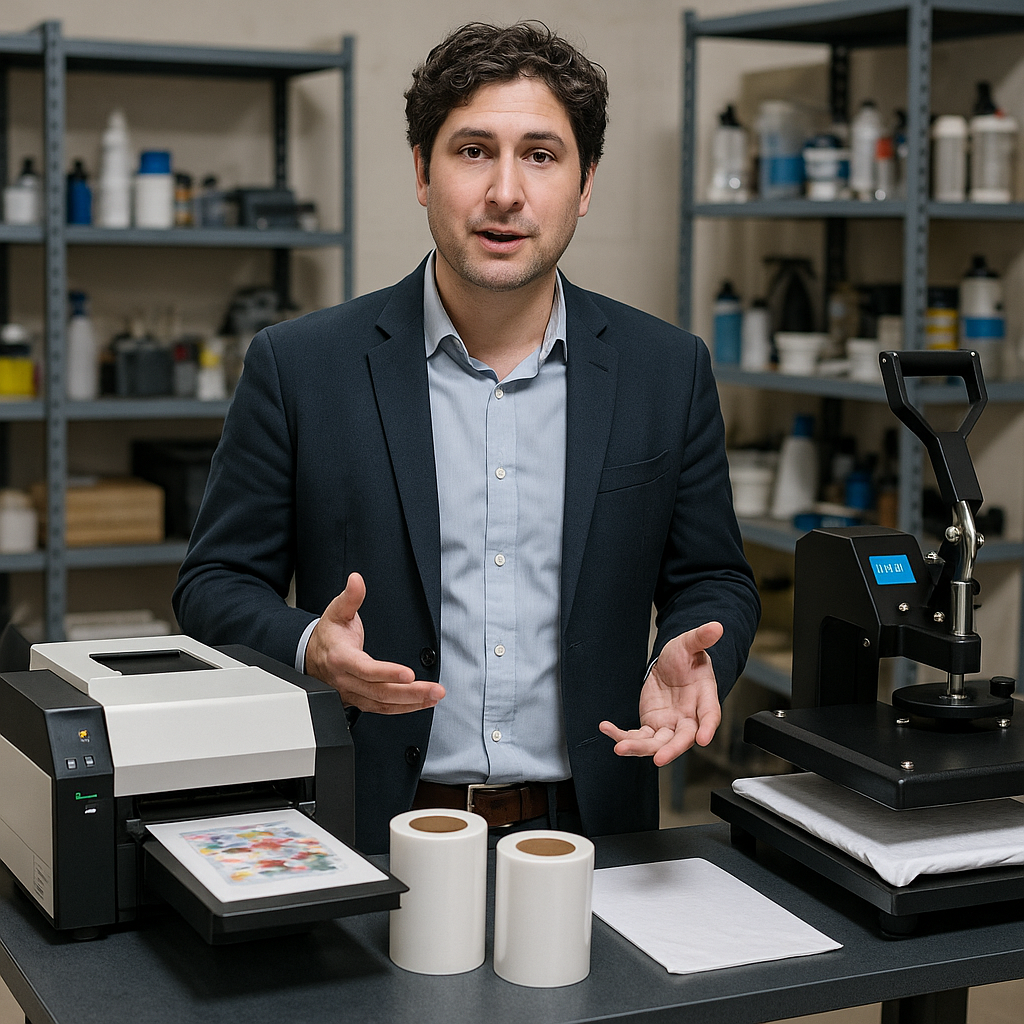
Popular DTF Applications:
-> T-shirts and other clothes made only for you
-> Team Wear and Sports Jerseys
-> Company Gifts
-> Canvas Bags and Other Things
-> Specialty Items: Shoes, hats, koozies, and more!
Business Models That Are Successful:
-> Custom orders in small batches
-> Sales on online marketplaces
-> Merchandise for businesses and events
-> Contracts for schools and sports teams
The DTF market is expected to grow to $7.9 billion by 2030, which is a great moment to get involved in this area.
Pro DTF Printing Tips By Michael
Based on what I’ve learned, here are my top tips for DTF printing success:
1. Buy Good Materials: In the long run, cheap film and inks always cost more.
2. Get to Know Your Heat Press Settings: Each mix of film, fabric, and design needs to be adjusted.
3. Keep Your Equipment Up to Date: Cleaning and calibrating your equipment on a regular basis can fix 90% of problems.
4. Test Everything: Always test things out before placing big orders.
5. Take Control of Your Environment: The findings are greatly affected by the temperature and humidity.
Frequently Asked Questions:
1) What is DTF printing best for?
DTF printing is excellent for making custom clothing, promotional items, and any other use that needs bright, detailed prints on different types of fabric. This is especially useful when you need to print on dark or cotton textiles that sublimation won’t work on.
2) How long do DTF prints last?
If you use the right materials and apply them correctly, DTF prints can endure 50 or more washes while keeping their colors bright. But they might shatter over time, unlike sublimation, which becomes part of the fabric.
3) Can I use a normal inkjet printer for DTF?
No, DTF needs specialized printers that can use DTF-compatible inks and white ink. The specific inks and films required are not compatible with regular inkjet printers.
4) How much does it cost to print with DTF?
The costs are very different; however, you should expect to pay $1–4 per print depending on the size, design intricacy, and number of prints. Small transfers may cost $0.50 to $1, while bigger ones may cost $3 to $5.
5) Is it worth it to do DTF printing?
Yes, of course! If you set the right prices and volumes, DTF printing can be quite profitable. A lot of my readers say that they make 200–400% more money on finished goods.
6) Which fabrics work best for DTF printing?
DTF works on almost all fabrics, including cotton, polyester, mixes, silk, rayon, and synthetic materials. Fabric color doesn’t matter, unlike sublimation.
7) What is the difference between DTF and heat transfer vinyl?
DTF has better detail and color gradients than vinyl, although vinyl may be cheaper for simple designs with only one color. For complicated, multi-color art, DTF is better.
8) How high should the resolution be for my DTF prints?
For optimal results, use a minimum of 300 DPI. Higher quality designs make prints that look sharper and more professional.
9) Can you stack or layer DTF prints?
It’s possible to layer DTF prints, but I don’t advocate it because it makes them too thick and could make them less durable when washed.
10) How hard is it to learn how to print with DTF?
You should be able to do basic tasks well in about 2 to 4 weeks. It takes a lot of work over the course of several months to master advanced techniques and fix problems.
Final Verdict:
I’ve been using DTF technology for years, and I can honestly say it’s one of the most exciting things to happen in custom printing. What does DTF printing mean? It’s a flexible and easy-to-use technology that gives many small enterprises and hobbyists access to new opportunities.
The initial cost may appear high, but DTF printing is a great option for anyone who wants to manufacture unique clothes because it is so flexible and can make a lot of money. DTF gives you chances that didn’t exist a few years ago, whether you’re moving up from sublimation as I did or starting over in the printing business.
To be successful at DTF printing, you need to know how it works, get good materials, and keep learning. The printing industry changes quickly, so it’s important to keep up with new methods and tools.
I hope this article helps you figure out what DTF printing is and if it’s the correct choice for you. SublimationPrintersHub.com has many guides on printing and reviews of printing equipment. I’m always here to help other printing fans succeed!



